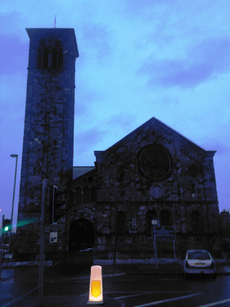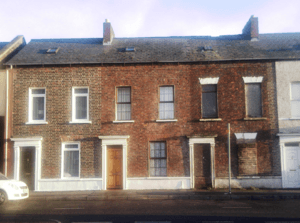Sailortown (Belfast) facts for kids
Sailortown was a working-class dockland community in the docks area of Belfast, Northern Ireland. Established in the mid-19th century on partly reclaimed land, it had a mixed Protestant and Catholic population. The 1907 dock strike called by trade union leader James Larkin commenced in Sailortown before spreading throughout the city.
Urban redevelopment in the late 1960s resulted in Sailortown's eventual demolition. As of 2021, only two churches, one pub and three houses remain of the once bustling waterfront enclave. However, a combination of private investment in the greater Docks area and building of social housing by associations such as Clanmill has led to a growth in population since 2010 in the Pilot St area.
A "sailortown" is a dockland area "that catered to the transient population of seafarers" that have existed in seaports throughout the world.
Location
Sailortown is in the Docks area north of Belfast city centre. It is bordered by Henry Street, York Street and the Whitla Street dock gate. It was adjacent to the old York Road railway station. Garmoyle Street serves as Sailortown's main arterial road, and at one time over 5,000 people lived in the small, cobblestoned streets of red-brick terraced houses packed between the docks and York Street. Visiting sailors from many European nations (in particular those bordering the Baltic Sea) and from even as far away as India and China added to the resident population, which was mixed Protestant and Catholic. People from all over the island of Ireland settled in Sailortown, including many who were left destitute during the Great Famine. The late 19th century saw the arrival of many Italian immigrants; this community, known as "Little Italy", was largely based around Little Patrick Street adjacent to the southern end of Sailortown.
The maritime-themed Sinclair Seamen's Presbyterian Church and St. Joseph's Chapel, a Catholic church, served as the places of worship for the Sailortown populace. Sinclair Seamen's church is still standing on Corporation Street as is St Joseph's, built in 1880 on Princes Dock Street. St Joseph's, however, is no longer in use, having been closed by the Diocese of Down and Connor in 2001, due to falling attendances and the lack of a local community. There is currently a community-led campaign for the renovation of St Joseph's chapel and it is opened on occasion for events.
The Midlands Hotel, adjacent to Sailortown on York Street, was once known as one of Belfast's most prestigious hotels. Notable guests included Laurel and Hardy and 1960s singer P. J. Proby.
History
The working-class enclave of Sailortown was established on partly reclaimed land in the mid-19th century and was Belfast's first waterfront village. It came into being in the period when Belfast's industry expanded and flourished; Sailortown was displayed on an 1845 Belfast street map. In addition to the docks and warehouses, Sailortown had linen mills, factories, a large fire station, a hotel, boarding houses, a variety of shops and businesses, and many pubs and taverns. Later there were a number of boxing clubs and cinemas. Many local men found employment as dock labourers, carters or merchant seamen; the women worked in the mills and cigarette factories. Most families had men away at sea, including boys as young as 14. During the period when Belfast reached its apex as the hub of the shipbuilding, engineering, and linen manufacturing industry, there were more than 2000 men working in the docks. The main distribution centre was beside the railway station with a constant flow of horses and carts passing through the main thoroughfares.
Life was hard for most of the people in Sailortown as they had to endure harsh working conditions with low wages and return home to small, damp, dilapidated homes, which often housed more than one family. The waterfront was described as having been "desperate with crime and inhumanity". As a result of these factors, Sailortown became closely affiliated with Irish trade unionism and the Labour movement. In January 1907, trade union leader James Larkin arrived in Belfast with the aim of organising the dock workers for the National Union of Dock Labourers (NUDL). He was successful in bringing the dockers and carters, both Protestant and Catholic, into the NUDL union. In May of that same year, he sent them out on strike after their employees refused their demand for higher wages, better conditions and union recognition. The strike soon spread across the city and the striking dockers and carters were joined by transport workers, coal heavers, shipyard workers, boilermakers, firemen, sailors, and factory workers. The strike lasted until 28 August, and was largely unsuccessful; the British Army was eventually sent in to restore order after the Royal Irish Constabulary (RIC) mutinied. The dockers' strike and lock-out did, however lead to Larkin establishing the Irish Transport and General Workers' Union (ITGWU).
Protestants and Catholics were not always segregated, often living in neighbouring houses and sharing the same workplace. As a rule, however, 'upper' Sailortown between Nelson St and York St was predominately Protestant, while the district closer to the chapel was mostly Catholic. Despite being host to a steady stream of foreign sailors, Sailortown was a close-knit community and viewed strangers with mistrust and suspicion. William Murphy, the father of loyalist Lenny Murphy (the leader of the notorious Shankill Butchers gang), was a dock labourer from Sailortown's Fleet Street. Jobs in Sailortown were traditionally passed from father to son; Lenny Murphy's grandfather had also worked as a dock labourer. Murphy was a common surname in Sailortown, albeit traditionally borne by Catholics.
Parts of Sailortown were damaged during the Second World War when the Luftwaffe rained bombs down onto Belfast on the nights of 7 April, 15/16 April and 4/5 May 1941, the Docks being a strategic target for the German bombers. Many buildings in Sailortown were engulfed with fire, the docks were hit and the Victorian York Street Spinning Mill was completely destroyed.
Demolition and redevelopment
The gradual demolition of Sailortown began in the late 1960s to construct the M2 motorway. The population was largely dispersed and rehoused in districts such as the Shore Crescent, a Protestant development adjacent to the Greencastle suburb of North Belfast, and the New Lodge. The last terrace of houses in Ship Street was knocked down in the 1970s. The Docks area has been extensively redeveloped and only three houses from the original Sailortown community remain standing. From the mid-1980s, the "Rotterdam Bar", an old historic pub at the corner of Pilot Street and the harbour gates close to Clarendon Dock, was a popular venue for live music – in particular alternative rock bands. The 19th-century pub was slated for demolition in 2008. That plan, however, was shelved, although the bar has been closed from the early 2010s.
The Sailortown Cultural and Historical Society was founded in October 1999. Since the beginning of the 21st century, some new houses and apartment buildings have been built in the area as part of a Sailortown regeneration scheme. St Joseph's is currently in a state of renovation and is opened for community events.
Sailortown in popular culture
Sailortown native John Campbell has published poems about Sailortown, and two of his books, Corner Kingdom and The Disinherited, are set in Sailortown's Docks. The latter book is based on the corrupt system which existed in the Docks beginning at the outbreak of the Second World War when men known as "Blue Button Men" were given preference in hiring over the Red Button Men who could only obtain work if they had fathers or brothers who were themselves employed as dockers. Novelist Eoin McNamee wrote about Sailortown in his novel Resurrection Man.
Playwright Martin Lynch's 1981 play Dockers vividly recreates Sailortown life in the early 1960s, its central theme being the fierce competition for jobs amongst the dockers and the power of the union which was the final arbitrator in who was hired or not.
Irish artist Terry Bradley was inspired by Sailortown to feature its dockers in a series of paintings.
Northern Irish singer/songwriter Anthony Toner's song "Sailortown" was written following a performance at the Rotterdam Bar. It is featured on his album A Sky For Every Day.







